On Saturday 13th of December we did our final shoot for the project. Overall i think it went according to plan and we managed to do everything that we had intended to do however there were a few minor hiccups which we had to overcome.
Monday, December 15, 2008
Re-Shoot 2
Posted by LATYMERMEDIA at 10:09 AM 0 comments
Labels: Evaluation, Re-shoot2, Reflections
Wednesday, December 10, 2008
Re-Shoot
On 9th and 10th of October we are going to re-shoot our sequence because when watching back our footage from our first shoot we found many errors and in order to make our sequence successful we feel that we should re-shoot.
We will all be arriving at Nisha's house at 2pm and then setting up the equipment. This time we will pay close attention to all the objects in the background as these are the elements that ruined some of our shots. As we need to wait for it to get dark before we can begin shooting, we will first start with various cut away shots that do not show the outside. We never shot that many cut aways before as we thought we did not need them but when watching back our footage we felt that they might help to add a bit of pace in our sequence. After we have done these cut aways we will then go onto shooting our main sequence.
Hopefully we will be finished shooting completely today so we need to be as vigilant and engaged as possible because if we waste time we will not get anything finished and then we will have to end up shooting again when we really do not want to be as we are already quite pushed for time on our schedule and we really need to begin editing our footage soon.
Posted by LATYMERMEDIA at 4:57 AM 0 comments
Labels: Evaluation, Re-shoot, Reflections
Friday, December 5, 2008
Reflections of the Group
On Tuesday Miss Blackborow made us discuss as a group what we thought was working well and what we thought we could improve upon as a group. We all sectioned off into our groups to begin with our discussions.
At first it was hard to think of anything as we all felt that as a team we were working well but as we started to think we all came up with a few issues that we felt were affecting the groups performance and if they were fixed we could work to a higher standard.
Some issues we agreed on and we all felt were extremely important. However some of them some people did not agree with so therefore we left them as smaller issues that could be dealt with later on in the project if they get any worse.
I felt that the main problem with our group is the lack of paper work. Its not the fact that we are not willing to do it, its just we never seem to be able to find the time. I feel that if we were able to allocate a few hours each to finishing off a few pieces of paperwork then our shoots would be alot more organised and things would run more according to plan. When bringing up this issue with the group we all felt the same on the situation and came to the conclusion that we would all try our hardest to do find the time to do a small section of the paperwork before the next shoot so that we would be up to date and therefore ready to move on.
Overall i felt this discussion was beneficial to the group as it helped us bring up a lot of issues that we were ignoring before and therefore we would be able to improve upon the general work standard of the group and the group dynamics.
Posted by LATYMERMEDIA at 5:13 AM 0 comments
Labels: Evaluation, Group, Reflections
Monday, December 1, 2008
THE REAL SHOOT!!
On Saturday 29th November we did our real shoot. We arrived at Nisha's house at 2:30pm and planned to begin shooting straight away to avoid getting behind again due to talking too much!
This did not go according to plan and we ended up starting late as we realised we needed the outside to be dark before we were able to shoot but once we begun we shot for 3 hours solid and managed to get all the footage we wanted.
I really enjoyed doing the shoot and our group worked well as a team. We came across a few problems which we did not plan for during our test shoot but we managed to work around these and overcome them.
The thing that i found hardest about the real shoot was getting the continuity correct. It was very hard to make our shots look plausible due to things around us changing and objects being in the shots that were not supposed to be there. When watching back over a few shots after we had shot them we found many faults with the continuity and ended up having to reshoot them. When we were doing our test shoot we did not encounter as many problems as we did not include as many shots and our test sequence was far less thought out. When shooting our trailers back in Year 10 we never had to worry about the continuity of the sequence so it was a lot easier then whereas now there were a lot more errors that we ran into. As it was an entirely new thing for all of us to focus on it made it a lot more challenging and difficult but i felt we tackled it well.
Another problem that we cam across was sound. Many of our shots had sound which was unclear or too soft which we had noticed during the test shoot but we thought that the use of the microphone might help. However it did not help so we decided that instead of using the sound with the shots, we just recorded seperate shots of just the sound which we will then group with the needed shot so that you can hear it clearly and therefore it will make more sense to the audience. This was another issue that we had never faced before because we have never really focused on sound when shooting previously. This is what made it a lot more confusing for all of us and brought to light more issues. I liked learning a new skill but i found that at times it was extremely complicated and sometimes frustrating as it could ruin the entire shot.
On Saturday, as Charlotte did all the acting, me and Nisha shared the shooting out equally between us. I felt this was beneficial to both of us as we were both able to have a time using the camera and therefore gaining more confidence. When one of us was not shooting we were always there helping the other person and giving advice which made the shoot run a lot more smoothly as we were able to get two peoples opinion rather than just one.
Overall i think it went really well as we achieved everything we had set out to do and managed to shoot all the needed footage. I cannot wait to start editing it together!
Posted by LATYMERMEDIA at 4:49 AM 0 comments
Labels: Evaluation, Reflections, Shooting
Tuesday, November 25, 2008
Reflections on the Test Shoot
We completed our test shoot on Monday 24th November. Overall i felt it went well and we achieved everything we set out to achieve. It showed us the areas which we needed to improve on in time for our real shoot and showed us the areas which worked really well and that we should definitely use in our real thing. The only aspect of our test shoot which we have still not yet achieved is deciding our final idea! We are still stuck between the two ideas because when it came to shooting them they both contained good and bad aspects and they both had lots of potential. Charlotte preferred the 2nd idea whereas me and Nisha preferred the first but as Charlotte is our actress we would prefer it if she liked what she was acting out. I think we will have to get feedback from as many people as possible and then the most popular idea we will go ahead with.
Posted by LATYMERMEDIA at 11:02 AM 0 comments
Labels: Planning, Reflections, Test Shoot
Thursday, November 20, 2008
Group Work
Now that we have begun planning for our test shoot, i feel our group are working well together and all the individual research that we have all done has been a lot of good as it helped us come up with the 2 final ideas that we are going to be testing in our test shoot. We are up to date with everything and we communicate really well as a group so if there is a problem we can overcome it. Hopefully by the end of Monday we will have one final idea to go along with so we can begin working really hard on making it perfect. I am really enjoying the project so far and look forward to the rest of it.
Posted by LATYMERMEDIA at 4:13 AM 0 comments
Labels: Final Project, Planning, Reflections
Wednesday, November 19, 2008
Idea For Group Project
- You see a girl leave her office and she begins to walk somewhere but we do not know where. The opening sequence will be the camera following the character to the place they are going and as it is in their POV the audience will only find out where they are going once they have arrived. The place they arrive at is a dingy, decrepit building with a young hostage tied up inside.
- The audience should feel scared, confused, suspicious, curious when they are watching this opening sequence. The main issues raised will be obsession, stalking, murder and revenge but these issues will only become apparent in certain parts of the opening.
- It is a real time sequence as the audience are seeing it through the characters POV so therefore it is happening whilst the audience are watching it. There is a small piece of dialogue right at the end of the sequence between the hostage and the woman when she enters the run down building. There will be a soundtrack and diagetic sound of the surroundings however the soundtrack will be played louder than the diagetic sound to create an atmosphere. I was thinking of having various cut aways to pictures of other girls or newspaper titles describing previous hostage victims which will make the audience think that the woman will be the next hostage victim when really she is the killer.
- Woman taking the journey-buisness woman, pencil skirt, white shirt, red hair, unattractive, middle aged, white, obcessive, murderer. Hostage - young girl, blood red lips, black eyeliner, smudged make - up, puffy eyes from where she has been crying, helpless, weak, short skirt, glittery top with blood stains on it, victim
- The sequence will take place in various locations as the woman is walking through a town and the camera follows her. The main locations that the camera focuses on are the dingy, run down, old building that is like a un used warehouse with very little light. It seems unhygenic and scary. The other location is the womans office which is like a state of the art, modern, glass, high rise building. It makes gives the impression to the audience that she is a professional buisness woman.
- The mise-en-scene changes as the sequence progresses. It goes from everyday lighting that is bright and sunny to dark eery lighting as she begins to walk down back alley ways and enters the horrible building. The overall visual style will be fairly normal that the audience will be able to relate to. It will feature shops and locations that the audience will be able to recognise and so therefore it will seem realistic but as the scene progresses the locations will become more unrecognisable and unnormal and the audience will then begin to suspect something. The dress codes will be a typical buisness woman's dress code with the pencil skirts and fitted shirts. The young hostage will be dressed like a typical teenager on a night out somewhere making it more relatable to the audience and therefore more chilling. The people that she encounters on the street will be dressed like an average person making the scene plausable. The mise-en-scene is trying to build up tension by moving from normal, average day surroundings to more unusual, frightening, distrubing ones and the audience will notice these changes and therefore become scared and confused.
- The camera will mainly be in the POV of the person walking therefore the movement of the camera will mimic the movement of the camera using tracking as if she is walking forward and whip-pans and pans to show the movement of her head turning etc. This will therefore mean there will be a range of shot distances and angles. Occassionally there will be cuts where we see the scene as if we are on lookers but these shots will only be brief and they will mainly be MLS and LS to act as establishing shots so that the audience get a sense of the surroundings.
- It will be a continuous sequence with a few examples of cross cutting between the main action and shots telling the background behind the main action (polaroids and newspaper titles). I will try and show off my knowledge of continuity editing as much as possible with the sequence by using match on action, shot-reverse-shot, eye line matchs and the 180 degree rule.
- Yes, a few of the questions are maybes but once i have presented my idea to the group we can adapt it to make it more suitable. It is just a starter idea that we can build up and create other elements around it.
- They liked the idea but they felt it would be too complicated to shoot as the weather is unreliable and due to there being a large amount of people on the streets the continuity would be difficult to get right. They felt that if we had longer to shoot it and our sequence did not have to be 2 minutes then maybe we could of gone ahead with it and worked on it further but due to the lack of experience we decided for a student film it was too complicated and difficult to do.
Posted by LATYMERMEDIA at 4:58 AM 0 comments
Labels: Final Project, Idea, Independent Research, Planning
Thursday, November 13, 2008
Groups for Coursework
We have now been told what groups we are going to be in for our coursework so we can now crack on with working on planning our opening sequence. I am happy to be working in a group with Nisha and Charlotte as they are two of my closest friends and i get on well with them. We have already arranged to have a few movie nights to do some research which should be good fun and i am looking forward to it. I am just worried we might spend too much time gossiping and having fun rather than working though but hopefully this wont happen. We all know when the talking should stop and the work should start! Anyway let the planning begin...
Posted by LATYMERMEDIA at 5:06 AM 0 comments
Labels: Coursework, Evaluation
Saturday, November 8, 2008
Preliminary Exercise
Here is our final sequence for our preliminary exercise that goes with the evaluation questions. I really enjoyed making this sequence as it was much more challanging and professional than we had ever done before. I hope you like it :)
Posted by LATYMERMEDIA at 5:23 AM 0 comments
Labels: Independent Research, Miss Blackborow, Preliminary Exercise, Video
Friday, November 7, 2008
Analysis of A DVD Cover
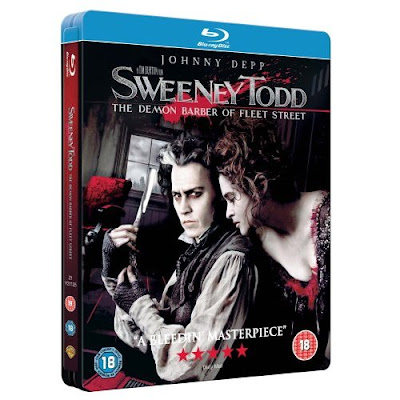
Posted by LATYMERMEDIA at 4:56 AM 0 comments
Labels: DVD Cover Analysis, Homework, Independent Research
Preliminary Exercise Questions
Posted by LATYMERMEDIA at 4:55 AM 0 comments
Labels: Homework, Independent Research, Preliminary Exercise, Question 6
Preliminary Exercise Questions
How Successful Was Your Sequence? Please Identify What Worked Well and With Hindsight, What Would You Improve/Do Differently?
Posted by LATYMERMEDIA at 4:54 AM 0 comments
Labels: Homework, Independent Research, Preliminary Exercise, Question 5
Thursday, November 6, 2008
Preliminary Exercise Questions
What Factors Did You Have To Take Into Account When Planning, Shooting and Editing?
Posted by LATYMERMEDIA at 5:53 AM 0 comments
Labels: Homework, Independent Research, Preliminary Exercise, Question 4
Preliminary Exercise Questions
What Technology Did You Use To Complete The Task, and How Did You Use It?
Posted by LATYMERMEDIA at 5:45 AM 0 comments
Labels: Homework, Independent Research, Preliminary Exercise, Question 3
Wednesday, November 5, 2008
Preliminary Exercise Questions
How Did You Plan Your Sequence? What Processes Did You Use?
We each were allocated with a task involved in the planning of our sequence so that everyone would be equelly involved in the process. We first of all discussed our ideas as a group and discussed appropriate actors, location and plot, then once we had roughly written down and story boarded our best idea we each went away and did our bit.
Shaun created a storyboard for our sequence so that we could see visually how each shot would look and how well they would fit together. It would give us a feel of how the sequence would flow when it is put together and it would help us decide what would be an appropriate order for our shots, in order to make the continuity correct.
Amelia and Mia then went on to construct a shooting script once we had decided on our shots and storyboarded them. This helped us find an appropriate order for our shots to be shot in so that it would take up as little time as possible and work most efficiantly. The shooting script was not the order that our shots would finally be put in, just an order that would make it easier and less time consuming as shooting the shots in the order they are storyboarded would take up too much time and there would be far too many mistakes involved in the continuity.
I then went away to write the script for our sequence. This would help us when it came down to the continuity of the sequence as the conversation shots would have to be shot a number of times and in order for us to be able to do effective continuity editing we would have to keep the dialogue the same.
We did a few run throughs of the sequence before it was shot just to make sure the actors and location were appropriate and worked with the plot. This would help prevent any problems that we could of come accross during shooting and gave us a chance to resolve them then and there.
Posted by LATYMERMEDIA at 5:07 AM 0 comments
Labels: Homework, Independent Research, Preliminary Exercise, Question 2
Preliminary Exercise Questions
Who Did You Work With and How Did You Manage the Task Between You?
My group consisted of Amelia, Mia, Shaun and me. We allocated everyone with different planning tasks so that we would all contribute an equal amount to the planning of the sequence. The camera work was mainly done my Mia and Shaun as Amelia and I were involved with the acting. We felt that this would be the easiest and most efficiant way of taking our shots rather than changing the roles every shot as it would have been very time consuming and we were under a strict time limit. With the editing we circulated it between the group, everyone doing 15 minutes of editing and people chipping in with ideas and help when people needed it. We found that this was the most effective way of doing it.
Overall i felt our group worked well together and we all pulled our weight to get the job done. There were no arguements or disagreements and everyone was willing to do the jobs they were given.
Posted by LATYMERMEDIA at 4:58 AM 0 comments
Labels: Homework, Independent Research, Preliminary Exercise, Question 1
Tuesday, November 4, 2008
Legally Blonde Opening Sequence
An opening sequence is the first part of your film that the audience see. It should captivate the audience and make them want to watch onto the rest of the movie. An opening sequence should set up the location and time, introduce the audience to the main character(s), contain music that is relevant to the film, set up the genre and future themes of the film, contain a few important credits, introduce the storyline, establish the key iconography, and set the pace of the film. If an opening sequence does all this it is highly successful, however it does not always have to contain all of these aspects for it to be a good opening sequence.
The 2001 film 'Legally Blonde' has an opening sequence that engages the audience and allows us an insider into the life of the main character. It is a fairly short sequence but in that space of time it manages to tell us a lot about the main character, the location and the general mood of the film. It sets it up to be a chick flick from the very beginning and introduces us to the storyline therefore living up to the audiences expectations and making them want to watch on.
The music is very happy and jolly and anchors what is going on on the screen. The lyrics 'Its a perfect day' are shown by the sunny sky, beautiful people and the main character getting ready for her boyfriend. It is emphasised by the use of high key lighting which makes everything seem far more perfect than it may be. The audience immediately know that the 'perfect day' is related to what is going to happen with the main character and her boyfriend as that is what the entire opening is leading up to, as that is what the card she is given is for.
The whole opening sequence is following the card that is being delivered to the main charcter. This is how we find out that the main character's name is 'Elle' as it is written on the envelope. The card starts off in the basket off a bike with a girl riding it through the town. The camera passes by many serorities and we get the feel of a typical American teenage community that is friendly and perfect. The bike rides into a serority called 'Delta Nu' and we know from this that the main character must belong to this serority. The camera then cuts to show Elle's dressing table with a mirror on it saying 'President'. The audience link the two and assume that she must be the president of the Delta Nu serority and therefore must be important and loved. We then follow the card through the serority showing all the good looking girls doing their makeup after showering and keeping fit. It is what the audience would expect to see from a very girlie serority and therefore it sets the scene up and lets the audience know that it is going to be an extremely feminie film.
There are many shots of Elle's belongings telling us a lot about the character just from what she owns and what the camera is showing her doing. We do not see her face until the very end of the opening sequence, however, from all the shots before this we can guess she is going to be a very made-up, stunning, blonde girl. This is because there are many establishing shots of her things such as nail varnish bottles, herbal essesnces hair dye, fluffy pens, glittery picture frames, fashion magazines, pink shoes, heart jewelry, Prada shopping bags etc. These shots all connote different things to the audience but the main thing it tells us about Elle is that she is the stereotypical blonde girly girl. The shopping bags tell the audience that she is a big fan of shopping and the fact that they are Prada tell us that she is wealthy and likes to shop designer wear. The nail varnish and various make-up products placed on her dressing table show that she is a very self-indulged character and she cares a lot about the way she looks. She obviously likes to be well groomed and this is anchored by the fact that in many of the shots of her she is indulging in her beauty regime which involves shaving her legs, painting her perfect nails and brushing her hair. There is a close up shot of a sash in her room saying 'Homecoming Queen'. This signals to the audience that she was homecoming queen at high school and therefore must be very popular. The picture frames on her desk show pictures of a chihuahua dog dressed in clothes. We can assume that this is her dog otherwise it would not be in a picture frame on her desk. It is something that a typical American blonde such as Paris Hilton would do with their dog and shows that she maybe aspires to be like that. It shows she is extremely girly and also loves her animals.
The first shot is a CU of her blonde hair swishing which immediatly ties in the tital of 'Legally Blonde'. It is an effective opening shot because it introduces the important part of the main character and therefore the storyline without giving anything else away. It is eye-catching and different and as it is the first shot the audience know that the blonde hair plays a big part in the role of this film.
Towards the end of the opening sequence you hear the main character talking on her phone and then see her opening her card and blowing a kiss to the picture of her boyfriend. The audience can assume that she is gossiping from what she is saying which is a very sterotypical girly thing and her tone of voice and actions show that she is ditzy and feminine, very much like what we would have expected to see leading up to it. The way she blows her boyfriend's picture a kiss shows that she cares a lot about him but also shows the audience that she is still young at heart as not many adults would do this. It therefore shows she is innocent and some what naive, setting us up for what is to come.
When Elle opens the card the audience get an insight into what all the fuss is about. We find out that Elle is getting ready to go out with her boyfriend, Warner, and so therefore something big must be about to happen. However the audience get the impression that everything is too good and perfect to be true and we can foresee something bad that will happen on this date.
The font used for the credits is pink and swirly, with hearts as dots for the 'i''s and very calligraphic joined up lettering. This emphasises the fact that the movie is very feminine and girly. It almost looks as if the writing of an American girl next door and therefore the audience can link this writing with the main character, Elle, and therefore anchor the fact that she is very fun, bubbly and a typical girl.
The audience find out all these elements from the way the opening sequence is shot and put together. Without it the story would be far more confusing as we would have never had the establishing shots introducing us to various things and giving us some background information, we would have just been thrown straight into the story and made to guess what was happening. This is why opening sequences are so important as they set up what the film is going to be for the audience and lets them know what is to come.
Posted by LATYMERMEDIA at 5:04 AM 0 comments
Labels: Homework, Independent Research, Opening Sequence
Sunday, November 2, 2008
Diegetic and Non-Diegetic Sound in Movies
Sound is used a huge amount in movies to create a certain atmosphere for the audience and to make scenes in films seem more realistic. There are two types of sound used in films and these are diegetic and non-diegetic. Diegetic sound is sound from the movie world, for example, a door closing or a train passing by. Non-diegetic sound is sound that has been added on after to create a particular effect, for example, a soundtrack or voiceover. Both are found in almost every film and they are often used together as they both create different things. It would be strange for the audience if both types of sound were not used in a film, diegetic because it would make the situation seem surreal as the sounds you would expect to hear in that place would not be occuring and non-diegetic because the the music normally signals what the audience should be feeling or what a particular character is feeling and without it it could become slightly confusing and uninteresting. Here are some examples of how sound is used in various well known films:
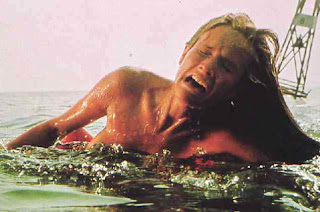 Diegetic - A lot of the sound where the party is taking place is diegetic sound. The man singing with his guitar, the sound of the crackling fire, the sound of the teenagers laughing and joking are all examples of the diegetic sound used.
Diegetic - A lot of the sound where the party is taking place is diegetic sound. The man singing with his guitar, the sound of the crackling fire, the sound of the teenagers laughing and joking are all examples of the diegetic sound used.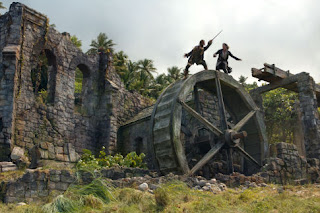 Diegetic - Throughout the whole scene the sound of swords is heard a lot as that is what they are using to fight. This is diegetic sound as the sound relates to the action taking place on screen and the swords would really be making that sound in real life when they are being used to fight.
Diegetic - Throughout the whole scene the sound of swords is heard a lot as that is what they are using to fight. This is diegetic sound as the sound relates to the action taking place on screen and the swords would really be making that sound in real life when they are being used to fight. 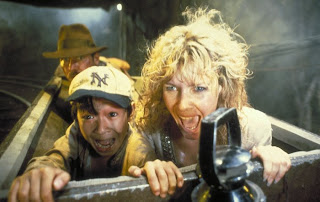 Diegetic - It is used a lot during this scene to make the action seem more plausible to the audience. The sound of the gun shots, the car screeching along the tracks, the sound of people being hit, the sound of falling wood, the sound of the mine cart whizzing along the tracks and the gushing water are all examples of where diegetic sound has been added to create a realistic effect. Without them the audience would be feel as if part of the action is missing as they all add to the overall film and grab the audiences attention the same way the visuals do. It tells the audience what is going on without them having to watch the screen. Each individual sound matches up with an action and they are all easily recognizable sounds to the audience.
Diegetic - It is used a lot during this scene to make the action seem more plausible to the audience. The sound of the gun shots, the car screeching along the tracks, the sound of people being hit, the sound of falling wood, the sound of the mine cart whizzing along the tracks and the gushing water are all examples of where diegetic sound has been added to create a realistic effect. Without them the audience would be feel as if part of the action is missing as they all add to the overall film and grab the audiences attention the same way the visuals do. It tells the audience what is going on without them having to watch the screen. Each individual sound matches up with an action and they are all easily recognizable sounds to the audience.Posted by LATYMERMEDIA at 10:08 AM 1 comments
Labels: Independent Research, Sound
The Narrative Image of A Film
A narrative image is so important to a film because it is what we think of the film before we actually see it. It is supposed to make us want to see the film and set up an enigma so that the audience feel they have to see it to find out the answer. It gives the film its own original identity and image, something new and unique that will grab the audience's attention but yet set up the genre so it attracts the right audience. To create a narrative image you have to market the film successfully and this includes things such as a posters, adverts, merchandising, websites and word of mouth endorsement. The success of a narrative image is about creating a fine balance between the expected and the unexpected and if the combination of the two is correct then your film should draw in a wide audience.
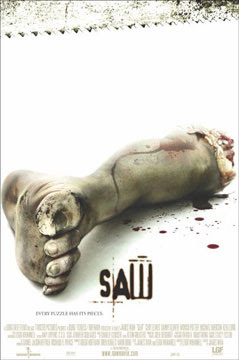 The poster has a very shocking CU image of a footthat has been severed off on it. It is in the middle connoting to the audience that it is extremely relevant to the film and the nature of the image immediately grabs the audiences attention.
The poster has a very shocking CU image of a footthat has been severed off on it. It is in the middle connoting to the audience that it is extremely relevant to the film and the nature of the image immediately grabs the audiences attention. 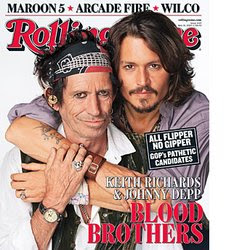
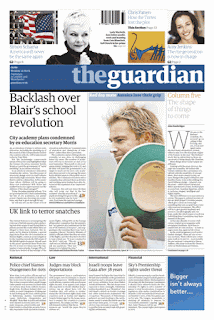 Before the film was released, many people had already begun talking about this new horror movie that was coming out. It set itself up to be truly terrifying and due to this many people were dying to go and see it to find out whether they could be brave enough to withstand it.
Before the film was released, many people had already begun talking about this new horror movie that was coming out. It set itself up to be truly terrifying and due to this many people were dying to go and see it to find out whether they could be brave enough to withstand it. Posted by LATYMERMEDIA at 5:03 AM 0 comments
Labels: Narrative Image, Research
Friday, October 17, 2008
Different Genres Mood Board
This is a mood board showing a variety of different genres in movies and some films that correspond to these genres. A genre is a vague catogory which films with similar qualities fit into. It is helpful to directors and producers when creating a film to know what genre it is being made to fit into. This is because it allows them to know the conventions that their film should follow and how they can make it unique without ruining the audiences expectations. To audiences it is helpful for them to know the genre because it allows them to make the desicion as to whether they want to watch the film or not. For example if they are lovers of the horror genre and see the film The Texas Chainsaw Massacre advertised to be shown, they will know to watch it as it will contain all the elements of a horror that they enjoy watching and will therefore be entertaining for them. Sometimes genres get too big and confusing therefore forcing the directors to create sub-genres such as romantic comedy, which contains the conventions of both the romantic genre and the comedy genre. This can make it easier for directors when creating a film as it allows them to be much less rigid with the conventions and allows them to use successes and inspirations from many different genres.

Posted by LATYMERMEDIA at 1:07 AM 0 comments
Labels: Independent Research, Mood Board, Research
Favourite Film Mood Board
Here is a moodboard of a few of my favourite films. They are my favourite films for many different reasons. Some of them have gripping plots, others have amazing actors and actresses but all of them keep me just as interested from start to finish. I can watch them over and over again and never get bored and many of them they have the same affect on the audience whether you are watching it for the first time or the millionth. They all vary in genre but they all have one thing in common, i can enjoy watching them, whatever mood i am in.
Posted by LATYMERMEDIA at 1:06 AM 0 comments
Labels: Independent Research, Mood Board
Romantic Comedy Mood Board
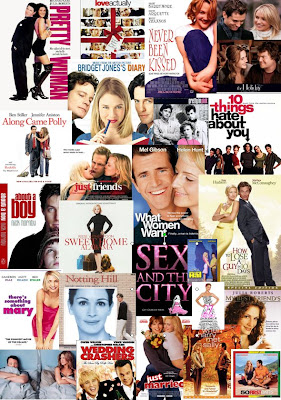
Posted by LATYMERMEDIA at 1:06 AM 0 comments
Labels: Independent Research, Mood Board
Influential Directors
I decided to do some research into influential directors in both today's film industry and the past. Directors can change the way films are made forever if they cross boundaries and break conventions and yet still create a highly successful film. Many people base their decisions as to whether to watch a film or not on who has directed the film. This is because they can look back at past films they have created and use this to judge whether the film that they want to watch will be good or not. Here are a few directors that really stood out when i was doing my research and many of them are household names amongst both the old and the young.
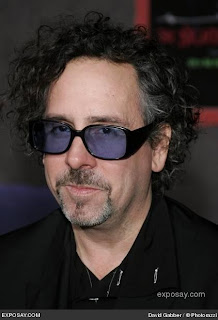 Born August 25th 1958. Many people believe him to be the most quirky director of all time. He produces films that have a slight dark and gothic undertone with plots that focus around misfits and outsiders, both physically and mentally, which is a highly unusual thing in the media industry as we tend to prefer to hear about and watch perfect people.
Born August 25th 1958. Many people believe him to be the most quirky director of all time. He produces films that have a slight dark and gothic undertone with plots that focus around misfits and outsiders, both physically and mentally, which is a highly unusual thing in the media industry as we tend to prefer to hear about and watch perfect people.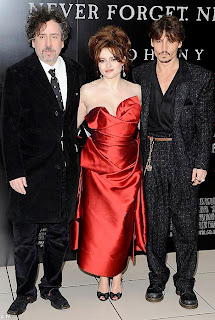 Both these stars appear in many of Burton's films with Johnny Depp being in many films such as Sweeny Todd- The Demon Barber of Fleet Street, The Corpse Bride and Helena Bonham Carter being in films such as The Planet of the Apes and Sweeny Todd - The Demon Barber of Fleet Street as they have gained a strong relationship with him and Johnny Depp describes him as 'a brother, a friend, my godson's father' which shows a bond that not many actors are ever able to have with the director. This shows a real uniqueness about Tim Burton and leads me to believe that despite him being a great director, a lot of his success comes from the friendships he has made
Both these stars appear in many of Burton's films with Johnny Depp being in many films such as Sweeny Todd- The Demon Barber of Fleet Street, The Corpse Bride and Helena Bonham Carter being in films such as The Planet of the Apes and Sweeny Todd - The Demon Barber of Fleet Street as they have gained a strong relationship with him and Johnny Depp describes him as 'a brother, a friend, my godson's father' which shows a bond that not many actors are ever able to have with the director. This shows a real uniqueness about Tim Burton and leads me to believe that despite him being a great director, a lot of his success comes from the friendships he has made 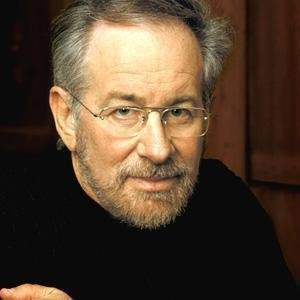 Born December 18th 1946, Steven Spielberg has lived his life and built up an incredible reputation for himself as a director and a person in general. He has been producing box office films since the 1970's and is still going now, producing some well known classics along the way such as Jaws and ET. In 2006 the magazine 'Premiere' named him "the most powerful and influential figure in the motion picture industry" and 'Time' magazine listed him as one of the '100 Greatest People of the Century'. He has not produced copies of the same film and plot lines to make his success, instead he has produced films across many different genres and touched many different themes and that is why he is so highly thought of.
Born December 18th 1946, Steven Spielberg has lived his life and built up an incredible reputation for himself as a director and a person in general. He has been producing box office films since the 1970's and is still going now, producing some well known classics along the way such as Jaws and ET. In 2006 the magazine 'Premiere' named him "the most powerful and influential figure in the motion picture industry" and 'Time' magazine listed him as one of the '100 Greatest People of the Century'. He has not produced copies of the same film and plot lines to make his success, instead he has produced films across many different genres and touched many different themes and that is why he is so highly thought of. 
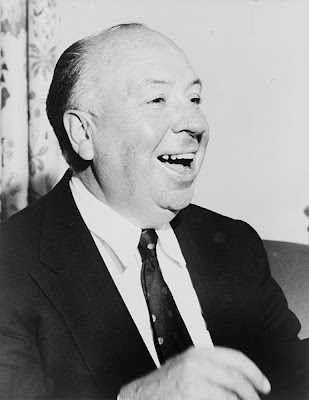 Born 13th August 1899 was an iconic and influential British director. During his life he directed over 50 feature films and had a career spanning for six decades. His work adapted as times changed and he successfully managed to produce films through the silent era right into the colour era. Despite his death he still remains one of the most well-known successful directors ever.
Born 13th August 1899 was an iconic and influential British director. During his life he directed over 50 feature films and had a career spanning for six decades. His work adapted as times changed and he successfully managed to produce films through the silent era right into the colour era. Despite his death he still remains one of the most well-known successful directors ever.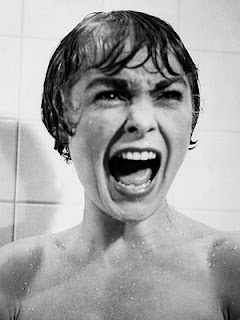
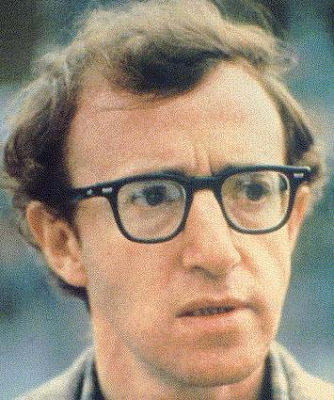 Born December 1st 1935, he is one of the world's best known directors and actors. His films have made him one of the most respected American directors of all time and holds a very large body of work. He gets his inspiration for his films from literature, sexuality, philosophy, psychology, Jewish identity, European cinema and New York City, where he was born and lived his entire life so he knows it very well.
Born December 1st 1935, he is one of the world's best known directors and actors. His films have made him one of the most respected American directors of all time and holds a very large body of work. He gets his inspiration for his films from literature, sexuality, philosophy, psychology, Jewish identity, European cinema and New York City, where he was born and lived his entire life so he knows it very well.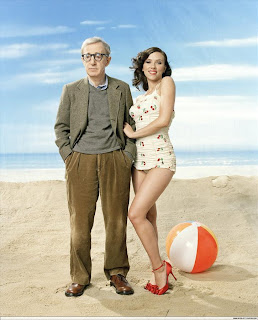
 Born November 17th 1942, Scorsese is a acadamy award winning American film director. His work is based heavily on contraversial issues such as Italian American identity, Roman Catholic concepts of guilt and redemption, machismo and the violence endemic to American society. Martin Scorsese is named one of the most significant and influential film makers of his era and as earned himself an MFA in film directing from NYU's School of Arts. He is the founder of the World Cinema Foundation and has recieved the AFI Life Achievement Award for his contribution in film. These along with many BAFTA's, Golden Globes and being the president of the Film Foundation make Martin a cut above the rest and truly stand out as an outstanding director.
Born November 17th 1942, Scorsese is a acadamy award winning American film director. His work is based heavily on contraversial issues such as Italian American identity, Roman Catholic concepts of guilt and redemption, machismo and the violence endemic to American society. Martin Scorsese is named one of the most significant and influential film makers of his era and as earned himself an MFA in film directing from NYU's School of Arts. He is the founder of the World Cinema Foundation and has recieved the AFI Life Achievement Award for his contribution in film. These along with many BAFTA's, Golden Globes and being the president of the Film Foundation make Martin a cut above the rest and truly stand out as an outstanding director.
Martin was born and raised in New York City by his father, a clothes presser and his mother, a seamstress. When he was a child his father often took him on regular visits to the movie theatre and it was at this stage in his life that he found his love for cinema. At this age he developed a passion for neo-realist cinema and has later said that The Bicycle Thief, Paisa, Rome and Open City all inspired him and influenced his way of thinking towards his Sicilian heritage. Scorsese originally wanted to be a priest but this was soon taken over by his interest in film. He attended the NYU Film School and it was here that he won his MFA in film directing in 1969.
During his time at the NYU Film School he made many short films such as What's A Nice Girl Like You Doing In A Place Like This? and The Big Shave which was one of his most famous short movies of that time. At the same time as making these short movies he was also producing his first feature length film. It was a black and white movie called Who's That Knocking At My Door and was about a trouble male protagonist. This was the start of what was to come, showing off a unique "Scorsese style" that would be used in many of his later films.
During the 1970's, Martin made another film called Boxcar Bertha which although wasn't a huge sell out, taught Scorsese the vital lessons he needed to learn, how to make movies quickly and cheaply which set him on his way to making his first major box office movie, Mean Streets which starred famous actor Robert De Niro. The two have been collaborating ever since and are now firm friends. 
After this breakthrough, he directed several other successful movies that were just as big in the box office such as Taxi Drivers and Goodfellas. All of his films featured the typical "Scorsese style" with the macho posturing, bloody violence, gritty New York mise-en-scene, Catholic guilt and redemption, rock soundtrack and speedy editing and he became well known for this individual style. In a way these became his conventions that he had to follow when making a film otherwise it would not live up to the audiences expectations.
Some of Scorsese's more recent movies include The Aviator and Gangs of New York which were both highly successful and nominated for many awards, most of which were for best director. In the future Scorsese is said to be working on a piece based on Shusaku Endo's masterpiece novel, Silence, about two Portuguese Jesuits amoung persecuted Christians in 17th Century Japan. It is said to be released in 2010 but no more is being revealed.
Over the years Scorsese has built up an impressive portfolio of work with big hit films in the box office all the time grossing huge amounts of money and many awards to show off his talents. It would be an understatement to say that Scorsese is just another talented director as i feel his skills are far more impressive and influential than many other directors and that is why i believe him to be one of the most influential directors.
The Coen Brothers

Joel Coen born November 29th 1954 and Ethan Coen born September 21 1957 are known professionally as 'The Coen Brothers'. Although they both direct and produce their films together, up until recently Joel recieved credit for directing and Ethan for producing. In the film industry they are known to many as 'the two headed director' as they hold very similar visions with films and when questioned they both give the same answer. Although people may believe that sharing the same career as your brother may not be the best thing, it has proven that you can achieve great success and to allow equality when it comes to crediting films, they sometimes label themselves under the joint name Roderick Jaynes.
When they were boys, Joel was the first brother to begin his journey to becoming a director. He used to mow peoples lawns in their neighborhood to get money for his Vivitar Super 8 camera. Once he had earned enough money the brothers collaborated with another neighborhood friend and they begun making remakes of movies that they had seen on the television.
After they graduated from their High School, Joel went on to become an undergraduate in a film program at the New York University where he made a 30 minute thesis film called Soundings. Ethan, however, went to Princeton university where he earned an undergraduate philosophy degree. Once Joel had graduated he became a production assistant for industrial films and music videos. It was here that he gained a talent for film editing.
In 1984, the brothers wrote and directed their first film together called Blood Simple. It was about a bar owner who hires a private detective to kiss his wife and her lover. It recieved much well deserved praise when it was released and won awards for Joel's directing at the Sundance and Independent Spirit awards. This movie was a glimpse into what was to come of the Coen brothers.
Since their first success they have continued to write and direct movies together. Some of their most well known ones are Barton Fink, which gained many Oscar nominations and won 3 major awards at the Cannes Film Festival, and No Country For Old Men, which was also nominated for many awards and won 4 Academy Awards. Another of the Coen brothers films that has just hit the big screen was called Burn After Reading. It is a black comedy starring Brad Pitt, John Malkovich and George Clooney about an ousted CIA official's memoir accidently falling into the hands of two unwise gym employees intent on exploiting their find. In its opening weekend the film grossed $19.1 million in the USA and Canada ranking first at the box office. Since then that has increased to a staggering $51.64 million and is still extremely popular in cinemas worldwide.
The brothers have a few more films up their sleeves that they are planning to release in the future. One is called A Serious Man which is said to be based loosely on their own childhoods. They are currently filming it at the moment and hope to release it in 2009. Another project they are set to embark on is the remake of the 1969 film True Grit which will begin to be made in 2010. 
Overall i think the brothers prove that two heads are better than one and that great minds really do think a like. Many people argue that they have it easy because they are a team but i feel that true success is just as hard to achieve both on your own and in a team and i think they have become very successful, producing many outstanding films. I think they are two extraordinary individuals and together they are even more inspirational.
Quentin Tarantino
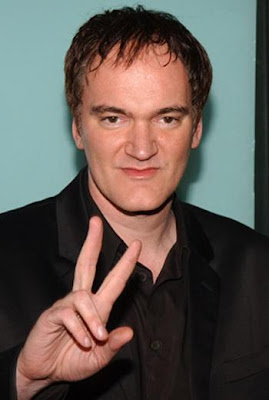
Born March 27th 1963, Quentin Tarantino is a legendary film director all around the globe. He rose to fame in the early 1990's as a filmmaker who broke the boundaries. He used non-linear storylines and aestheticization of violence. Since his breakthrough he has just become more and more famous producing many well known films. His hard work has earned him many Acadamy, BAFTA, and Palme D'or awards and nominations for both Emmy's and Grammy's. Along with these he was also named 12th greatest director of all time in 2007 by 'Total Film' magazine.
Son of Tony Tarantino, an actor and amateur musician, he always had the film industry in his blood. At the age of 16 Tarantino dropped out Narbonne High School in California and went on to learn acting at the James Best Theatre Company. This section of his life was highly influential in his movie making career. At the age of 22 he then went on to get himself a job at Manhatten Beach Video Archives where he spent all day discussing and recommending films to customers.
Tarantino later met Lawrence Bender at a Hollywood party, who encouraged him to write a screenplay. This encounter led to the release of Quentin's film Reservoir Dogs at the Sundance Film Festival in January 1992. Although Quentin wasn't the sole director of this hit film, he wrote the script in 3 and a half weeks and begun him on the road to success as his name became globally recognized as the film was so critically acclaimed. After this he was offered many directing opportunities for films such as Speed and Men in Black but he turned all of them down so that he could move to Amsterdam and work on the script for his second major hit film, Pulp Fiction which was released in 1994 and once again became hugely popular worldwide.
Since these two major movies, Quentin has gone on to direct other major box office hits such as Kill Bill Volumes 1&2. It was a 'revenge flick' in the cinematic style of Chinese martial arts, Japanese period cinema, Spaghetti Westerns and Italian horror. It was based upon a character and plot that himself and leading actress, Uma Thurman, had developed during the making of Pulp Fiction.
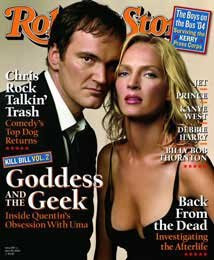
At the moment Tarantino is currently working on a project called Inglorious Basterds said to be released in 2009. It is the story of a group of guerilla U.S. soldiers in Nazi occupied France during the 2nd World War. It is set to be just as big a hit as his many other films.
Posted by LATYMERMEDIA at 1:05 AM 0 comments
